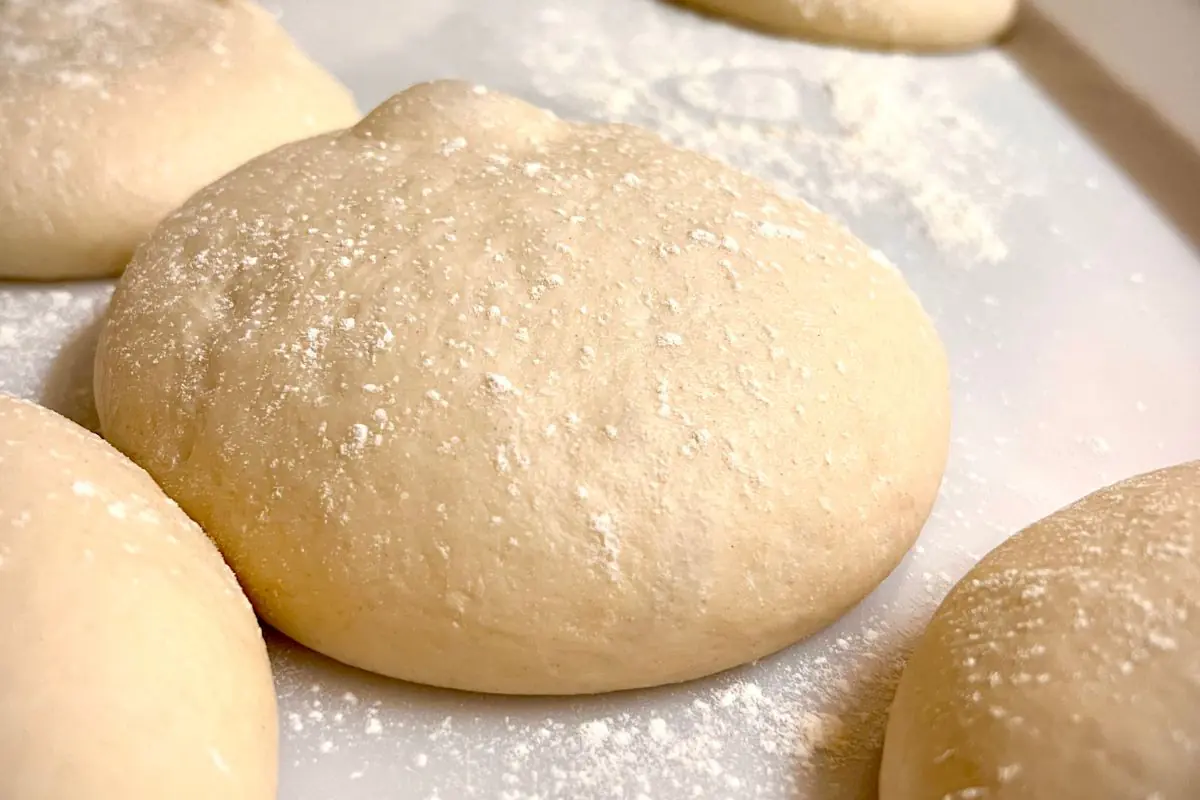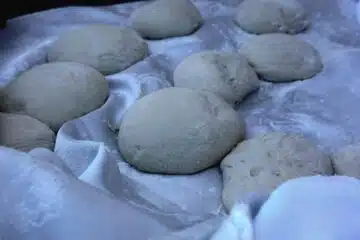No, you do not have to use pizza dough immediately. It can be refrigerated or frozen for later use.
Crafting homemade pizza is a delightful experience, and understanding how to handle pizza dough can make all the difference in your culinary adventure. Pizza dough, while often thought of as an immediate-use ingredient, actually offers flexibility for the at-home chef.
Proper storage not only extends the life of your pizza dough but also empowers you, the home cook, to plan your kitchen efforts beyond just one meal. Whether you’re in the mood for a spontaneous pizza night or planning a future feast, understanding the art of pizza dough preservation can elevate your pizza-making game. This knowledge not only allows for efficient kitchen management but also sparks creativity, as you can decide to whip up a fresh pizza with the dough you’ve astutely stored at any time.
The Shelf Life Of Pizza Dough
Understanding the shelf life of pizza dough ensures a perfect crust every time. The longevity of the dough varies based on different factors, such as the freshness of the ingredients and storage conditions. Let’s explore how long pizza dough can last before it’s time to toss it out. Signs of spoiled dough include a sour smell, mold growth, or a slimy texture. If you notice any of these, it’s best to discard the dough.
Fresh Dough Vs. Store-bought
Fresh pizza dough often has a shorter shelf life than store-bought options. Homemade versions last a few days, while commercial products stay fresh longer. This difference comes from preservatives used in store-bought dough. Check out the specifics below:
| Type | Refrigerated Shelf Life | Freezer Shelf Life |
| Fresh Dough | 1-2 days | Up to 3 months |
| Store-Bought | 1-2 weeks | Up to 4 months |
Factors Affecting Dough Longevity
Several factors determine how long pizza dough will last. Be mindful of the following aspects:
- Ingredients Used: Freshness and type impact shelf life.
- Temperature: Storage temperature is crucial; keep it cool.
- Exposure to Air: Minimize exposure to prevent drying.
- Humidity Levels: High humidity can spoil dough faster.
For best results, store dough in an airtight container or plastic wrap. This helps maintain freshness and prevent contamination.

Myth Vs. Reality: Pizza Dough Usage
Welcome to the delicious world of homemade pizza, a realm where the suppleness of your dough can make or break your dish. In the quest for that perfect crust, home cooks and pizza specialists often find themselves facing the question: “Do you have to use pizza dough immediately? Let’s debunk the myths and uncover the reality behind pizza dough usage.
The Immediate Use Myth
Contrary to popular belief, pizza dough is not a one-time-use ingredient. It’s a versatile culinary tool that can be used beyond the immediate moment. In fact, it undergoes a fascinating process known as fermentation, which not only enhances the flavor and texture of the dough but also contributes to that famous pizzeria taste. So, instead of rushing to roll out your dough right after it’s made, consider the possibilities it offers and experiment with different resting periods for unique flavors and textures.
Optimal Timeframes For Use
So, when is the dough at its prime? The sweet spot for using dough depends on several factors, including the recipe and your personal preference for flavor and texture.
| Type of Dough | Resting Period | Usage |
| Standard yeast dough | 1-24 hours | Keep in a cool area, covered, to rise slowly |
| Slow-rise dough | 24-72 hours | Refrigerate to develop flavor and texture |
| Quick dough | 30 minutes – 1 hour | Use immediately for a speedy meal |
- A brief rest — for doughs requiring minimum fermentation
- Long fermentation — for a deeper, more complex flavor
- Keep an eye on the dough’s rise during the chosen resting period, noting that colder environments may slow down the process.
Remember, pizza dough is forgiving and adaptable. Even if you’ve left it to rest for longer than recommended, it can still be brought back to its full glory with a little planning. So, don’t fret if your schedule doesn’t align perfectly with your pizza-making plans. Aim for the sweet spot your recipe calls for, and rest assured that you can still enjoy the fruits of your labor — a delicious, homemade pizza.
Storing Pizza Dough
After crafting the perfect pizza dough, understanding how to store it is crucial. Whether you need to keep it for a few hours or several weeks, proper storage methods ensure your dough remains fresh and ready for your next pizza creation. Let’s dive into how to keep your pizza dough at its best with refrigeration and freezing techniques.
Refrigeration Techniques
Need to use your dough within a few days? Refrigeration is the way to go. Follow these simple steps to keep your dough fresh:
- Lightly oil the dough ball to prevent drying.
- Seal the dough in a clean, airtight container.
- Label the container with the date to track freshness.
- Place the container on the refrigerator’s bottom shelf.
Chilled dough should last up to 5 days. Let it sit at room temperature for an hour before use for best results.
Freezing For Extended Use
Won’t be making pizza for a while? Freeze your dough with these steps:
- Divide the dough into individual pizza portions.
- Oil each portion and place in separate freezer bags.
- Press out air from the bags and seal tightly.
- Label the bags with the date.
- Store in the freezer for up to 3 months.
When you’re ready to make pizza, thaw the dough in the fridge overnight. This slow thawing process helps the dough retain its moisture and prevents it from becoming too sticky. Then, let it come to room temperature before stretching it out. This step is crucial as it allows the gluten in the dough to relax, making it easier to stretch and shape.
Preparation Matters
Every successful pizza starts with the perfect dough. But do you need to use your dough right away? Not at all! In fact,
Proper dough preparation and storage can elevate your pizza game. Whether you’re a seasoned chef or a home cook,
Understanding the dough’s lifecycle is key. Let’s dive into the steps you need for the best pizza base,
From pre-dough preparation to post-dough care.
Pre-dough Preparation
Before even mixing your ingredients, consider these:
- Measure ingredients with precision—balance is key.
- Temperature affects the yeast; keep ingredients at room temperature.
- Opt for quality flour—it makes a difference.
Only start mixing when you’ve checked these off. This pre-planning ensures consistency and quality in your dough.
Post-dough Prep And Storage
You’ve mixed your dough. What’s next? These tips will help.
- Let it rise. Patience rewards with flavor and texture.
- Excess dough? Store it right. Wrap it well in plastic wrap and then a zip bag.
- Refrigerate for a short time or freeze for up to three months.
Remember, chilled dough needs time to come back to temperature. Allocate time to rest the dough before rolling out your masterpiece.
The Science Of Yeast Fermentation: Common Mistakes To Avoid
The Science of Yeast Fermentation plays a crucial role in making pizza dough. It’s what makes the dough rise, giving it the perfect texture and flavors. Yeast, a living microorganism, feeds on the sugars in the flour, producing carbon dioxide and alcohol. This process is fermentation. Let’s dive into what happens over time as the yeast works its magic.
Yeast Activity Over Time
Understanding Yeast Activity Over Time is essential for perfect dough. Yeast begins working the moment it’s mixed with flour and water. But it sometimes acts at different speeds. Here’s what yeast does:
- First Hour: Yeast is waking up and starting to feed.
- Next Few Hours: It produces gas, making dough grow.
- Long Fermentation: Slows down, adding complexity to the dough.
Longer waits can result in better dough. They allow the yeast to fully develop flavors. Yet, if you wait too long, the yeast exhausts its food, and the dough deflates.
Flavor Development
Yeast isn’t just about making dough rise. It’s also about flavor. Over time, yeast’s action on the sugars creates delicious by-products. Here is what contributes to the flavor:
| Time | Effect on Flavor |
| Initial Hours | Mild taste |
| Extended Fermentation | Rich, nuanced flavors |
The longer the fermentation, the more complex the taste.
Subtle sour notes and a deep, yeasty aroma emerge,
You are making your pizza crust irresistible.
The Texture Game
Fresh, homemade pizza dough is the foundation for the perfect pizza delight. Timing plays a crucial role in its creation. The dough’s texture can make or break your pizza experience. Let’s explore the importance of crust texture and overproofing.
Impact On Crust Texture
Choosing the right moment to bake your pizza dough is an art. It’s about balancing rise and density for that ideal bite. A well-timed dough leads to a crust that’s:
- Chewy on the inside
- Crispy on the outside
If you use the dough too soon, it will lack the gases needed for a light, airy crust. If you wait too long, it will go flat. Yeast, temperature, and time are your tools for crust perfection.
When Dough Becomes Overproofed
Dough that sits too long enters the over-proofed stage. This means:
| Yeast Activity | Crust Result |
| Too much fermentation | Collapsed structure |
| Excess gas production | Dense, hard texture |
Dough’s peak performance passes, leaving it with a lifeless, tough character. To avoid this, keep an eye on the dough’s volume. It should almost double, not triple.
Spotting Spoiled Dough
Welcome to the curious world of pizza dough preparation!
Pizza dough, the backbone of a delicious pizza, often raises a question:
Should one use it immediately, or can it wait?
Identifying dough that’s past its prime is crucial for both safety and taste.
Visual And Olfactory Clues
Bakers rely on their senses to judge dough quality.
Visual and olfactory signs can alert you to spoiled dough.
- Color changes: Spot any grey hues? Time to discard.
- Texture issues: Dough should feel pliable, not sticky or slimy.
- Unusual smells: A sour or off odor is a clear warning.
If the dough fails these checks, it is best not to risk it.
Health Risks Of Old Dough
Using old dough isn’t just a recipe for a flavor flop.
It poses serious health risks. Here’s why:
| Health Risk | Reason |
| Food Poisoning | Bacteria thrive in the old, improperly stored dough. |
| Allergic Reactions | Mold development can trigger severe allergies. |
| Digestive Issues | Expired yeast can disturb your gut health. |
Staying alert to these signs ensures your pizza is both safe and superbly tasty.
Expert Tips For Perfect Pizza Dough
Crafting the ultimate pizza starts with the dough, which is key to a delicious crust. But questions abound. Do you need to bake it right after mixing, or can it wait? This section focuses on the timing of dough use and how to revive dough from storage for the ultimate pizza experience.
Timing Your Dough Use
Timing is crucial for the perfection of pizza dough. It can make or break your pizza. Let’s discover some tips on how to time your dough perfectly.
- Fermentation is your friend: This process takes time but gives the dough its flavor and texture.
- Room temperature rise: Let it sit for a couple of hours.
- Cold fermentation: Store in the fridge for up to 3 days for a developed taste.
- Dough balls: Portion before rising for consistent crusts.
- Too soon? No worries. Freeze for later use.
Reviving Dough That Has Been Stored
Saved dough can still be a pizza star. Let’s breathe new life into it.
- Plan: Transfer from the freezer to the fridge the night before.
- Reach room temperature: Remove from fridge and wait a few hours.
- Gentle warmth: A warm bowl can speed up the thawing.
- Isn’t it rising? Add a pinch of yeast to spark life into the dough.
- Texture off? A bit of flour or water can adjust consistency.
Common Faqs Debunked
Pizza dough is more forgiving than you might think. Many home chefs ask, “Do I have to use pizza dough immediately?” Let’s tackle some common questions and debunk the mysteries surrounding pizza dough preparation.
Can You Over-knead?
It’s indeed possible to over-knead pizza dough. When the dough gets kneaded too much, it becomes tough. This means your pizza won’t have that light, airy crust we all love.
Signs of over-kneading:
- Resistance: Dough snaps back when stretched.
- Shiny Surface: The dough looks glossy, not matte.
- Heavy Texture: The pizza base feels dense.
Effects Of Ambient Temperature
Temperature plays a key role in pizza dough’s rise time. If your kitchen is warm, the dough will rise faster. A cooler environment slows down the yeast activity.
Temperature tips:
| Temp (°F) | Rise Time |
| 68-70 | Longer rise for more flavor. |
| 75-78 | Standard rise time |
| 80+ | Quick rise, watch closely. |
Is it storing dough in the fridge? This slows yeast activity even more. Cold dough needs time to warm up before baking, or it won’t rise well in the oven.


Frequently Asked Questions
Do You Have To Use Pizza Dough Right Away?
No, you do not have to use pizza dough right away. It can be refrigerated for up to 72 hours for later use, enhancing the flavor.
Can You Make Pizza Dough And Use It The Next Day?
Yes, you can make pizza dough and use it the next day. Store the dough in an airtight container in the refrigerator for best results.
How Long Can Pizza Dough Last In The Fridge?
Pizza dough can last up to 5 days in the fridge when stored in an airtight container or tightly wrapped in plastic wrap.
What Happens If You Don’t Wait For Pizza Dough To Rise?
Skipping the rise of pizza dough results in a dense, flat pizza with less flavor. The dough will not have the airy, chewy texture that comes from proper fermentation and proofing.
Conclusion
Understanding pizza dough’s flexibility is crucial for any home chef. You can refrigerate it for later, ensuring freshness and flavor. Plan, create delicious meals, and never compromise on quality. Your dough, your pace – enjoy the art of pizza making on your terms.

As the author of the “Ultimate Pizza Guide: Recipes, Tips & Secrets Revealed,” I’m dedicated to sharing my love for pizza and empowering others to create delicious homemade pizzas with ease. Join me on a journey to uncover the secrets to perfecting your pizza game!



